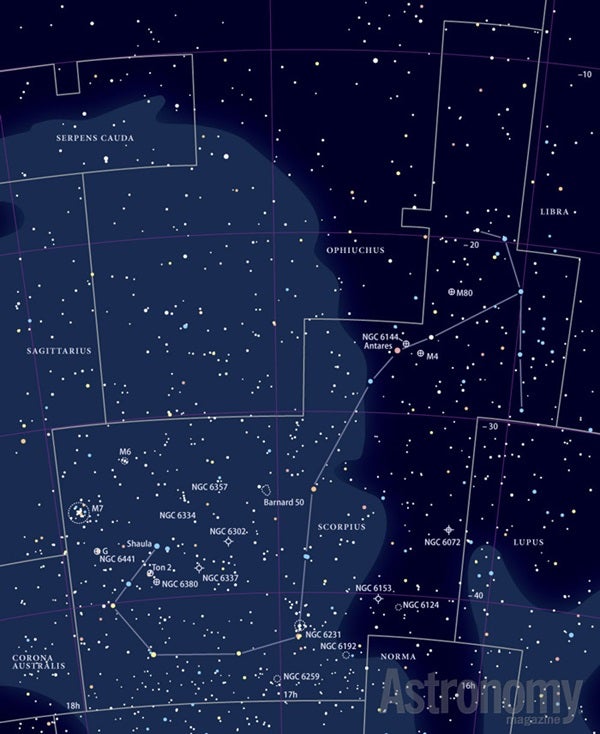Targets for June 18–25, 2015
Small telescope:
Open cluster NGC 6416
Large telescope:
Globular cluster NGC 6380
Large telescope:
Spiral galaxy NGC 6384
This week’s small-telescope target is open cluster NGC 6416 in the constellation Scorpius. This treat lies in an incredibly rich region of the Milky Way 5.2° north-northeast of magnitude 1.6 Shaula (Lambda [λ] Scorpii). Another way to find this cluster is to look a bit less than 1° east of the bright open cluster M6.
Through a 4-inch telescope at a magnification of 75x, you may have trouble picking this cluster out of the background even though it shines at magnitude 5.7. Look for a slightly denser region of irregularly spaced stars 15′ across in the shape of an isosceles triangle whose apex points toward the southeast. If you observe NGC 6416 though larger instruments, I’d suggest you keep the power low unless you’re trying to split the few double stars within the cluster.
A “Ton” of a cluster
This week’s first large-scope object is globular cluster NGC 6380, which also lies in Scorpius. It glows faintly at magnitude 11.5 and measures only 3.9′ across.
This challenging object lies 1.5° west of magnitude 2.4 Kappa (κ) Scorpii. We view this globular through 35,000 light-years of interstellar material, so just spotting it is prize enough. Through a 12-inch telescope, NGC 6380 appears as a faint, broadly concentrated haze.
NGC 6380 also carries the designation Tonantzintla 1, or Ton 1, derived from Tonantzintla Observatory, which lies near Puebla, Mexico. From that observatory, Turkish astronomer Paris Pismis discovered this globular cluster and another, even fainter one — Ton 2 — in 1959. To see magnitude 12.2 Ton 2, look 25′ east of NGC 6380.
A boxy galaxy
This week’s second large-telescope target is spiral galaxy NGC 6384 in Ophiuchus the Serpent-bearer. Now here’s an odd duck: a reasonably bright galaxy — magnitude 10.4 — in Ophiuchus. You’ll find this object 3.7° northwest of magnitude 2.8 Cebelrai (Beta [β] Ophiuchi).
Through an 8-inch telescope at 150x, this galaxy appears nearly rectangular, measuring 6.2′ by 4.1′. It has a broad, bright central region that orients from the north-northeast to the south-southwest. Larger aperture scopes and higher magnifications reveal a faint halo that hugs the core.
Done with NGC 6384, and ready for a bit of a challenge? Look for magnitude 13.9 NGC 6378, a small spiral galaxy, 0.9° to the south-southwest.
Expand your observing at Astronomy.com
StarDome
Check out Astronomy.com’s interactive StarDome to see an accurate map of your sky. This tool will help you locate this week’s targets.
The Sky this Week
Get a daily digest of celestial events coming soon to a sky near you.
Observing Talk
After you listen to the podcast and try to find the objects, be sure to share your observing experience with us by leaving a comment at the blog or in the Reader Forums.











